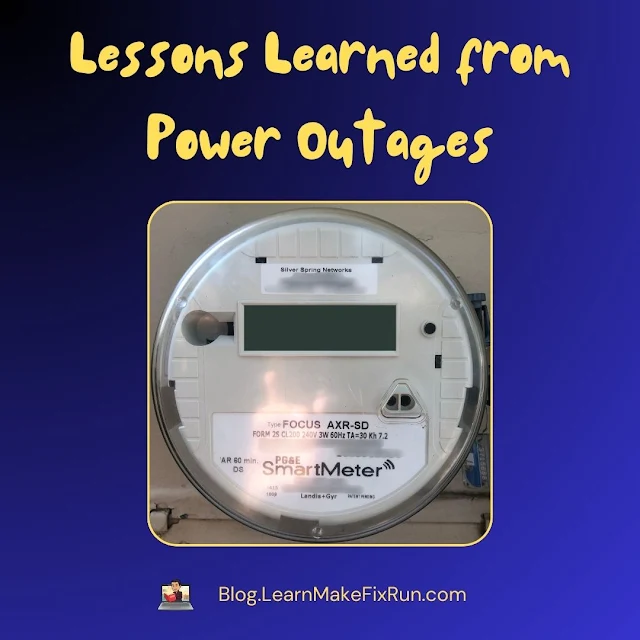Lessons Learned from Power Outages
A couple of years ago, the slight possibility of a public safety power shutoff (PSPS) due to wildfire, combined with the fact that an earthquake could cut off our power for days, resulted in purchasing a portable generator. (I’ll share more about our generator setup in a future post.) Setting up the generator takes time and labor, so I generally wait to see if power comes back quickly before I set it up. The delay in setting up the generator was unacceptable during distance learning and teaching/administrating from home. I bought a small, uninterruptible power supply (UPS) for our modem and wi-fi router.
Last winter, we lost power for 17 hours starting after dinner. When the power went out, the cable modem and wi-fi router kept working. We did not need to rely on the overloaded and slow cellular service, like everyone around us, to report and learn more information about the outage. My wife was able to continue grading papers in Google Classroom. There were two downfalls with our setup. By my design, only 2 hours of battery backup was available to run the modem and wi-fi. The thought was if internet access was critical, I could get the generator running before the batteries ran out. The other minor annoyance is that the UPS doesn’t have a silent feature to turn off the beep, indicating you are running off battery power that sounds every 30 seconds.
That night, about two hours into the power outage, the beeps on the UPS sounded continuously for approximately 30 minutes as it ran out of battery. It should sound continuously for 2 minutes by manufacturer design. However, our load was so low it lasted much longer. Around 12:30 am, the battery died, and thankfully, we no longer needed the internet.
The following day, I set up the generator, plugged the UPS into the generator, and waited for cable internet. While setting up the generator, I received a message that there was a Comcast outage. A couple of hours later, I heard a generator running outside an AT&T equipment box on the street. I surmised that the Comcast equipment ran out of battery backup power. When the power came back 17 hours later, so did cable internet.
Last year, when I switched to fiber internet, the technician told me that fiber doesn’t need electrical power between the central office and the house. The central office has built-in backup power generators, and as long as I have power for the modem, I’ll have internet. Fast forward to the recent atmospheric river that walloped California. When we lost power, the UPS kicked in (and beeped). We switched our devices from our home wi-fi router to the built-in wi-fi from the AT&T gateway and were up and running.
This experience has taught me that having a small UPS is very useful in power outage situations. For long-term outages, fiber internet appears to have the advantage over cable internet. It has also proved the concept that a UPS is uninterruptible if it has a charged battery. The power cord can be moved from a non-working wall outlet to a working generator, and you will not miss a beat.
What’s your plan for power outages? Do you have any experiences to share about solar power and backup batteries (Powerwall), portable battery packs, or permanent generators with an automatic transfer switch? Let me know in the comments below.




Comments
Post a Comment